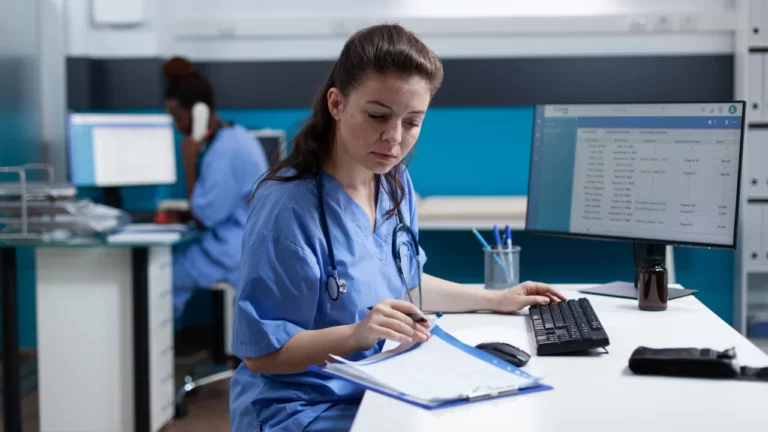Remote monitoring is a rapidly growing field in healthcare, with the potential to improve patient outcomes and reduce healthcare costs. A recent study published in npj Digital Medicine revealed how the Mayo Clinic developed a multisite, interdisciplinary remote patient monitoring (RPM) program that resulted in minimizing needless hospital readmissions and enhanced patients’ recovery from the illness. According to an examination of data from over 7,000 patients across 41 states, the two-tiered RPM program with nursing care was safe, effective, and resulted in excellent outcomes. By utilizing technology and telecommunication tools, remote monitoring enables healthcare providers to continuously monitor the health status of patients outside of traditional healthcare settings such as hospitals or clinics. This approach can help identify potential health issues early on, leading to more efficient and effective treatment. However, to truly maximize patient outcomes through remote monitoring, it is essential to develop and implement effective strategies for managing and operating remote monitoring programs.
Effective strategies may include choosing the right platforms, designating a remote monitoring lead, training team members, implementing policies and procedures, evaluating results regularly, and learning about remote monitoring. By understanding and applying these strategies, healthcare providers can ensure that remote monitoring programs are operating at the highest level of effectiveness and that patients receive the best possible care.
Remote monitoring is a critical component in the care of hospitalized patients. However, not all hospitals have the resources to implement remote monitoring programs. Remote monitoring allows healthcare providers to track patients’ vital signs, symptoms, and medication adherence from a distance, which can help to improve patient outcomes and reduce the risk of hospital readmissions. This article will discuss how providers can maximize patient outcomes through effective remote monitoring strategies.
Choose the Right Platforms for Remote Patient Monitoring
Choosing the right platforms for remote monitoring is crucial in maximizing patient outcomes and reducing healthcare costs. The platform selected for a remote monitoring program should be able to effectively support the specific needs of the patients and healthcare providers involved. Factors to consider when choosing a remote monitoring platform include the data types that need to be collected, the patient’s ability to use the platform, and the level of support required.
Different types of platforms are available such as cloud-based, device-specific, and others. It is essential also to consider if the platform can integrate with existing healthcare systems and have the necessary security and privacy features. Careful consideration of these factors can help ensure that the chosen platform is the most appropriate for the remote monitoring program and ultimately contribute to maximizing patient outcomes.
Designate a Remote Monitoring Lead
Designating a remote monitoring lead is an essential strategy for maximizing patient outcomes through effective remote monitoring. A remote monitoring lead is responsible for coordinating and overseeing the remote monitoring program, ensuring that it is properly implemented and effectively meeting the needs of patients and healthcare providers. The remote monitoring lead should be knowledgeable about the technology and best practices for remote monitoring and effectively communicate with and engage patients, healthcare providers, and other stakeholders.
The remote monitoring lead should be able to identify potential issues and develop solutions to overcome them, develop and implement protocols for patient engagement and ensure data integrity, accuracy, and confidentiality. Additionally, the remote monitoring lead should be responsible for the continuous improvement and evaluation of the program and the decision-making process to adopt the new technology. A dedicated remote monitoring lead can ensure that the program is operating efficiently and effectively and can adapt to changing needs to maximize patient outcomes.
Train Team Members
Training team members is essential for maximizing patient outcomes through effective remote monitoring. Team members, including healthcare providers, caregivers, and administrative staff, play an essential role in remote monitoring programs’ implementation and ongoing operation. By providing training, team members will be able to effectively use the technology and tools necessary for remote monitoring, understand the best practices for patient engagement and data management, and respond to the patient’s needs, concerns, and issues. It’s essential to have team members who can manage and operate the technology, interpret the data and make good clinical decisions, analyze the data to understand trends and identify any potential issues that may arise with the program.
If team members can do all of this, it ensures that the remote monitoring program is operating effectively and efficiently and that patients receive the highest quality of care. Additionally, ongoing training and education opportunities can help team members stay current on the latest technologies and best practices in remote monitoring, which will contribute to further improving patient outcomes.
Implement Policies and Procedures for Effective Remote Patient Monitoring
Implementing policies and procedures is a crucial strategy for maximizing patient outcomes through effective remote monitoring. Establishing clear guidelines for the operation and management of remote monitoring programs can help ensure that the program is implemented correctly, data is collected and managed appropriately, and patient privacy is protected. These policies and procedures should cover patient engagement and communication, data collection and management, security and confidentiality, and incident response.
Having clear and well-defined policies and procedures also contribute to consistency and standardization across the program, which can help identify any potential areas of improvement and measure the program’s effectiveness. Additionally, it is essential to keep policies and procedures up-to-date to reflect changes in regulations, best practices, and new technologies. It also may be beneficial to involve key stakeholders, such as healthcare providers and patients, in the development of policies and procedures to ensure that they are comprehensive and take their needs into account. By implementing policies and procedures, remote monitoring programs can be more effectively managed and operated, leading to better patient outcomes.
Evaluate Results Regularly
Evaluating results regularly is an essential strategy for maximizing patient outcomes through effective remote monitoring. Periodically reviewing and analyzing data collected through remote monitoring programs can provide essential insights into the program’s effectiveness and identify areas for improvement. This includes monitoring the patient outcomes, such as tracking patients’ vital signs and medication adherence, as well as gathering feedback from patients, healthcare providers, and staff on the remote monitoring program.
By regularly monitoring and evaluating the results, it’s possible to identify patterns, trends, and areas for improvement, as well as measure the program’s success in meeting its goals and objectives. The analysis should be done by a designated team or person, who should also report results back to the relevant stakeholders, including patients and healthcare providers. Additionally, it’s essential to use the evaluation results to inform continuous improvement and decision-making processes to achieve better patient outcomes.
Never Stop Learning About Patient Remote Monitoring (Because It’s Always Changing)
Learning about remote monitoring is an essential strategy for maximizing patient outcomes through effective remote monitoring. Remote monitoring technology and best practices are constantly evolving, and healthcare providers, staff, and patients need to be aware of the latest advancements and how they can be applied to improve patient care. This can include attending industry conferences and workshops, participating in continuing education programs, consulting with experts in the field, and staying up-to-date with the latest research on remote monitoring. By staying informed about the latest developments in remote monitoring, healthcare providers and staff can make more informed decisions about the implementation and operation of remote monitoring programs and identify new opportunities for improving patient outcomes. Additionally, learning more about remote monitoring can also help identify gaps in the current technology, and determine the potential best areas where research and development should be focused. Continuous learning by all staff members involved with RPM can ensure that remote monitoring programs are operating at the highest level of effectiveness and that patients receive the best possible care.
Invest in the Right Technology
Investing in the right technology is crucial for maximizing patient outcomes through effective remote monitoring strategies. This can include wearable devices, telehealth platforms, and electronic health records (EHRs) that allow for the collection and analysis of patient data in real time. By using these technologies, healthcare providers can more easily track patient progress and adjust their care plans as needed. Additionally, remote monitoring allows for earlier detection of potential health issues, which will likely lead to more timely interventions and improved outcomes.
Investing in the right technology can also help to increase patient engagement and compliance with treatment plans, which can further improve results. Many remote monitoring devices and platforms are available, so it is crucial to choose the one that best fits your healthcare practice’s needs. Consider factors such as ease of use, connectivity, and data storage when selecting remote monitoring technology.
Establish Clear Communication Protocols
Establishing clear communication protocols is crucial for maximizing patient outcomes through effective remote monitoring strategies. Patients should be given a clear understanding of when and how to contact their healthcare provider in case of an emergency. Healthcare providers should also establish clear protocols for responding to patient calls and messages, as well as for how to handle patient data. These protocols should outline how patients will be communicated with among healthcare providers. They should also establish a system for how and when healthcare providers will respond to patient inquiries and concerns. Such a system helps to ensure that patients are receiving timely and accurate information, which is essential for effective remote monitoring.
Clear communication protocols also help to establish trust and build strong relationships between healthcare providers and patients, which can further improve patient outcomes. Additionally, clear communication protocols can help to minimize confusion and errors, which can be especially important in remote monitoring scenarios. Overall, establishing clear communication protocols can help to ensure that patients are receiving the best possible care through effective remote monitoring strategies.
Utilize Remote Patient Monitoring Services to Gain Advantages
Utilizing remote patient monitoring (RPM) services is one way to maximize patient outcomes through effective remote monitoring strategies. RPM services are typically provided by companies that specialize in remote monitoring technology and can provide healthcare organizations with a variety of benefits. Some of the benefits of implementing RPM services into a healthcare organization follow:
Access to Advanced Technology: RPM services can provide healthcare organizations with access to advanced technology that they may not have the resources to develop or purchase on their own. This advanced tech can include devices such as remote monitoring sensors, software platforms for data collection and analysis, and mobile apps for patients to use.
Improved Data Management: RPM services can also provide improved data management for healthcare organizations. These services typically have secure, robust systems for collecting, storing, and analyzing patient data, which can help healthcare providers to more effectively identify potential health issues and track patient progress.
Increased Patient Engagement: Implementing RPM services can also help to increase patient engagement by providing patients with easy-to-use mobile apps and other tools to track their own health data. This can lead to increased patient satisfaction and better patient outcomes.
Remote Monitoring Expertise: The implementation of RPM services will provide healthcare organizations with the expertise of remote monitoring specialists. These experts can provide guidance and support on how to effectively implement remote monitoring programs, how to interpret data, and how to identify potential health issues.
Cost-effective: In many cases, outsourcing an established and proven remote patient monitoring service is more cost-effective than developing and maintaining in-house remote monitoring programs. It can be beneficial for healthcare organizations, particularly those with limited resources, to outsource remote monitoring to a specialized service provider.
Expected Patient Outcomes that Can Be Achieved through Effective Remote Monitoring Strategies
Remote monitoring has become an increasingly important tool for healthcare providers looking to maximize patient outcomes. By utilizing remote monitoring technology, healthcare providers can track patients’ vital signs, symptoms, and medication adherence from a distance and with more frequency, which can help to improve patient outcomes and reduce the risk of hospital readmissions.
Remote monitoring has the potential to greatly improve patient outcomes and reduce the risk of hospital readmissions. By effectively implementing remote monitoring strategies, healthcare providers can ensure that they are providing the best possible care for their patients, even from a distance. Remote monitoring is an effective tool that can be used to improve patient outcomes and provide better access to care for patients in remote or underserved areas.
To achieve these expected outcomes, healthcare providers must effectively implement remote monitoring strategies. This includes investing in the right technology, training staff and patients, establishing clear communication protocols, and regularly monitoring progress. With these strategies in place, healthcare providers can ensure that they are providing the best possible care for their patients, even from a distance.
It is worth noting that Remote monitoring is not a one size fits all solution; it should be used as a complementary tool for the clinical decision-making process, in conjunction with and complimentary to evaluating the patient’s clinical history and physical examination, and not as a replacement for traditional methods.
Improved Management of Chronic Health Conditions
One of the most significant benefits of remote patient monitoring is the ability to more effectively manage chronic health conditions, such as diabetes and heart disease. By regularly monitoring patients remotely, healthcare providers can identify potential health issues before they become more serious. Early identification of problems can lead to improved patient outcomes and a reduction in hospital readmissions.
Increased Patient Engagement
Remote patient monitoring can also increase patient engagement in their own healthcare. Patients who can monitor their own vital signs and symptoms from home will likely feel more empowered and in control of their health. to the result will likely be increased patient satisfaction and better patient outcomes.
Reduced Hospital Readmissions
Remote patient monitoring can also help to reduce the risk of hospital readmissions. By regularly monitoring patients remotely, healthcare providers can identify potential health issues before they become serious enough to require hospitalization. Regular and consistent remote monitoring has been proven to help reduce the number of hospital readmissions, which can save healthcare organizations money and resources.
Increased Access to Care
Remote patient monitoring can also increase access to care for patients who live in remote or underserved areas. By providing patients with the tools to monitor their own health remotely, healthcare organizations can reach patients who might otherwise not have access to care.
Improved Medication Adherence
Remote patient monitoring can also improve medication adherence by allowing healthcare providers to track if and when a patient has taken their medication. By ensuring that patients are taking their medication as prescribed, healthcare providers can improve patient outcomes and prevent complications from arising.
How DrKumo RPM Solutions Maximize Patient Outcomes
DrKumo is changing the way people obtain great health care all throughout the world. DrKumo provides the most effective solutions to both patients and healthcare providers through an innovative, collaborative, and technology-driven culture. DrKumo technology is simple to use and effective; it incorporates wireless medical sensors into RPM technology and employs a mobile app that collects all necessary data from the sensors and transfers it in real-time to an Intelligent Cloud Service, allowing doctors to access patients’ information and monitor them around the clock. Doctors can constantly stay in touch with patients and guarantee that they are safe and healthy with this real-time data sharing. DrKumo stresses patient happiness and guarantees that patients are always cared for by professionals and have access to doctors when needed.
DrKumo created what could be the first extremely secure remote patient monitoring platform for healthcare providers that supports disease management programs (DMP). Healthcare providers can efficiently manage the care of their chronically ill patients remotely by incorporating RPM and DMP into their practice. This unique combination of technology contributes to better overall care and management of chronically sick patients, resulting in better outcomes and a higher quality of life for these people.
Takeaways
Remote monitoring has the potential to significantly improve patient outcomes and reduce healthcare costs by enabling healthcare providers to continuously monitor the health status of patients outside of traditional healthcare settings. However, to truly maximize patient outcomes, it is essential to develop and implement effective strategies for managing and operating remote monitoring programs. These strategies include choosing the right platforms, designating a remote monitoring lead, training team members, implementing policies and procedures, evaluating results regularly, and learning about remote monitoring.
By understanding and applying these strategies, healthcare providers can ensure that remote monitoring programs operate at the highest level of effectiveness and that patients receive the best possible care.
Additionally, continuous evaluations and improvements to the strategies and technology used can adapt and evolve with the fast-paced development of technology and the patient’s need. Implementing effective remote monitoring strategies is a crucial step toward delivering high-quality and cost-effective care to patients.
Achieve more outstanding patient outcomes through effective remote monitoring strategies. Contact DrKumo now.








